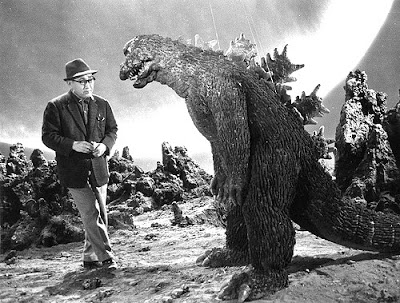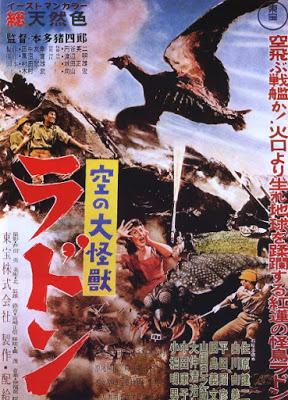Still circling back a bit
in the Kaiju Eiga filmography. I first came across Rodan in Ghidorah, The
Three-Headed Monster when it came out from under a pile of rocks on Mount
Aso, which is the largest live volcano in Japan. I was curious how Rodan
ended up buried under those rocks like a reptilian Jimmy Hoffa. Not that
Hoffa wasn't a special kind of reptile. This was as best as I can tell the
third Kaiju film from Toho., but the first in color. There was Godzilla in
1954 which was a big smash, Godzilla Raids Again in 1955 which was not. They
thought they should give the Big Boy a break (not seen again till 1962) and
came up with Rodan. I like Rodan. Both the movie and the monster. Rodan is
a victim of circumstance. Almost an innocent bystander. Something brought
him back to life from prehistoric times - hatched an egg - perhaps posits
one scientist it was radiation. But maybe it was something else. The desecration
of the earth. Rodan is not a villain here - in fact there is no real villain
- just humans being humans.
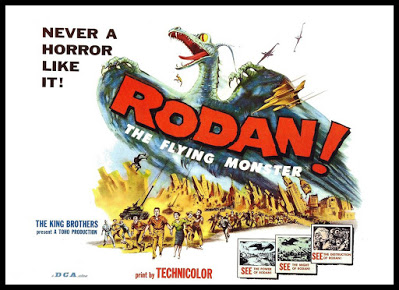
The film takes place in a small coal mining community on the island of Kyushu.
Digging deeper and deeper into the earth and taking away its treasures. Something
is down there though. It is stirring. A miner is ripped to pieces, three more
that go to investigate come to the same fate. Very claustrophobic and creepy.
It could have been its own movie. Initially, they think it is a miner killing
these people. The sister Kiyo (Yumi Shirakawa) is immediately shunned by
the community and it is a relief when he shows up dead. Rather dead than a
murderer. She is comforted by Shigeru (Kenji Sahara, who went on to appear
in tons of Kaiju films). He is as close as we get to a hero in the film but
no one is really the hero either - it is a communal effort of police, scientists
and the military. Very Japanese.
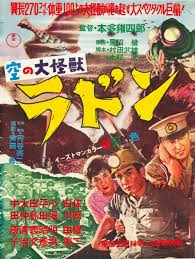
It turns out that the men are being killed not by Rodan but by these vicious
larva insect creatures that they call Meganeura (a real thing from 300 million
years ago). Rodan actually snacks on them. He or they since there are two
of them don't make an appearance till the one hour mark. A giant winged monster
- a Pteranodon (see Radon in there). It can fly at enormous speeds and seems
impervious to weapons.
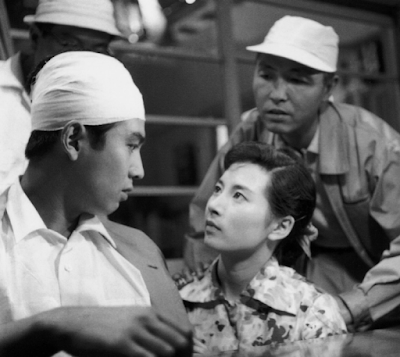
It is all done very well - perfectly paced at 82 minutes - some great scenes
and the miniaturization is stunning. When Rodan flies over a town flapping
his wings it creates great destruction - buildings falling apart, buses and
cars sent flying, a bridge toppling into the water - all incredible looking
and all done in miniature. Really nifty. You just have to sit there
and admire the artistry involved. There are no huge Godzilla like set pieces
in this film of cities being crushed under foot or monsters attacking one
another - so some may be disappointed but it was fine with me. The ending
is a bit anti-climatic - really not fair to Rodan and his mate who have not
asked for any of this but man has to kill what it doesn't understand. Glad
to see he made it back eight years later.
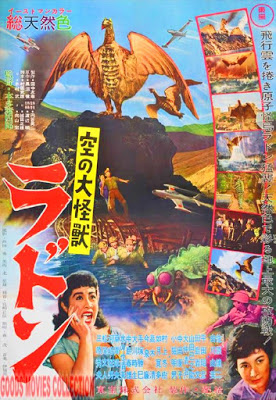
This film plus the other three I have seen plus many that I have not seen
are credited basically to three men. All three had been in the film business
for years when suddenly they were sucked into the world of Kaiju. Tomoyuki
Tanaka had begun working for Toho in 1940 and became a producer in 1945. He
was to become one of the most enduring producers in Japanese film - not only
producing many of the Kaiju films but Akira Kurosawa films as well. He was
the one who came up with the idea of a giant monster created by atomic energy.
Not that this was a radical or original idea as a number of giant monster
films were being made in America. But those were B films, these were top
films beautifully shot with top rated actors. At first the monster was going
to be an octopus - maybe that would have worked but we like Godzilla just
the way he is. A sociopath.
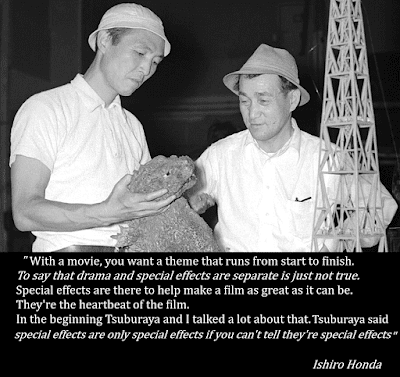
He turned to Ishiro Honda, a veteran filmmaker already - first as
an Assistant Director (for Akira Kurosawa before the Kaiju films and also
much later on) in the 1930s and then a director since the early 50's. He
especially liked the idea of bringing in the theme of radiation and wanted
the film to be serious in that regard. And the theme of peace as well. He
had fought in the war in China , become a prisoner and survived the fire
bombings of Tokyo. This clearly influenced him. The third main leg was the
man who created the special effects, Eiji Tsuburaya. He started off in the
film business in the late 1920s at Sochiku and over the years took on various
jobs - camera man, designer and special effects. He had apparently been a
big fan of King Kong since childhood but he didn't use stop-motion animation
but went with miniatures and men in suits. He got so good at it that during
the war he made these propaganda films that were so realistic that the Americans
thought his recreation of Pearl Harbor was real photography of the attack.
He joined the team and the three of them would go on working together for
years. Another name should probably be thrown in that group - the composer
Akira Ifukube, who composed the music for nearly 300 films and many of the
Honda films. This biographical info gathered from A Critical History and
Filmography of Toho's Godzilla Series by David Kalat. Hopefully, he knows
of what he speaks. I am still trying to learn the basics.
